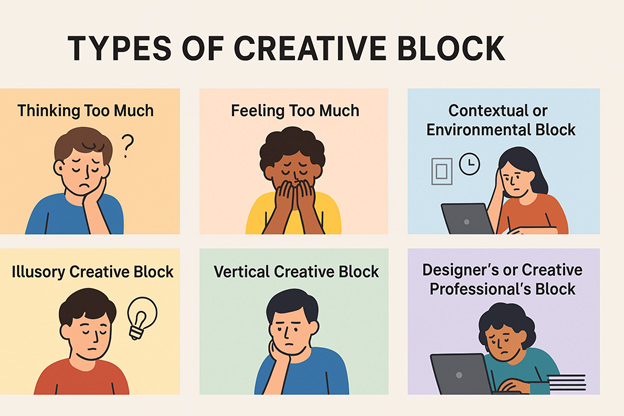

A creative block is probably the biggest nemesis for any creative person. There is nothing more frightening than staring at an empty screen, a blank page or a colorless canvas. What’s worse is when you’re desperately trying to fumble into the right ideas as the deadline approaches.
Lack of inspiration and creative fatigue is a real challenge for people working in a creative ad agency. While different people experience creative blocks differently, there are some common tips that can help us push through.

Creative block is the frustrating experience of feeling unable to generate new ideas, complete work, or move forward on a project. It can affect anyone—writers, designers, marketers, or artists—regardless of experience. Often, it is not a lack of ability but a temporary barrier that interrupts creative flow. These blocks happen when the mind becomes overloaded, stressed, or caught in self-doubt. External pressures such as deadlines, client expectations, or even monotonous routines can also trigger a block, making it difficult to create freely.
Many creative blocks stem from internal struggles. Perfectionism, fear of failure, and self-criticism often keep individuals from starting or finishing their work. Anxiety or burnout can drain energy and motivation, making it harder to focus. Emotional weight—such as stress from personal life—can also spill into creative tasks. On the other hand, overconfidence or lack of clarity about direction may cause stalling too. Recognizing these mental and emotional triggers is the first step toward overcoming them.
Sometimes creativity stalls because the mind is overanalyzing every possibility. This “analysis paralysis” makes starting feel impossible. Instead of letting ideas flow naturally, the creator gets caught up in questioning whether an idea is good enough.
Emotions like fear, insecurity, or vulnerability can create heavy resistance. When feelings dominate the process, creativity takes a backseat, leaving the person stuck in worry rather than expression.
A repetitive or uninspiring environment can dull creativity. Working in the same space, following the same routine, or dealing with constant distractions may limit fresh thinking. A change in surroundings often helps reignite imagination.
This block happens when someone believes they have “nothing left to say.” In reality, it’s not a lack of ideas but the illusion of being empty. This mindset can be dismantled by realizing that inspiration often returns when least expected.
Here, the challenge lies in being stuck in a narrow way of thinking. Instead of exploring new directions, the mind keeps circling the same patterns, making it hard to innovate.
Professionals in creative industries often face burnout from constant demands. When projects pile up, deadlines press, and inspiration feels forced, even the most skilled creators struggle to produce their best work.

One of the biggest obstacles in overcoming creative block is the harsh inner critic. This inner voice constantly questions whether ideas are good enough, often shutting down the creative process before it begins. Reframing the inner critic means shifting from judgment to curiosity. Instead of asking, “Is this perfect?”, try asking, “What can I explore here?” By viewing ideas as experiments rather than final outcomes, creators free themselves to play, explore, and discover new directions without fear.
Many people fight against the emotions that come with creative struggles—fear, doubt, frustration. But resisting these feelings often makes them stronger. A more effective approach is to accept and normalize them. Recognizing that every creator faces moments of uncertainty helps reduce the pressure to feel inspired all the time. By giving space to emotions rather than suppressing them, the mind relaxes, making room for ideas to flow more naturally.
Perfectionism is a common driver of creative block, as it sets unrealistic standards that feel impossible to meet. The key to breaking through is to embrace imperfection and allow work to evolve step by step. Starting small—sketching a quick idea, writing a rough draft, or brainstorming freely—removes the pressure of creating something flawless immediately. These small beginnings often spark momentum, leading to breakthroughs that perfectionist thinking would otherwise prevent.
Dealing with a creative block starts with accepting that it’s okay to feel uninspired. Take a break and get involved in some other activity. Sometimes forcing it makes it more difficult to create new content, and we might end up making a bigger mess.
A stagnant environment can often lead to stagnant thinking. Working in the same space with the same routine may limit fresh perspectives. Simply changing your surroundings—moving to a café, a library, or even a different corner of your home— can help spark new ideas. Exposure to new sights, sounds, and interactions stimulates the brain in unexpected ways, often leading to breakthroughs.
Pushing through creative fatigue rarely works. Taking a genuine break—away from screens, tasks, and deadlines—allows the brain to reset. Activities like walking, exercising, or meditating give the subconscious mind time to process ideas in the background. Many creators find that their best ideas come after moments of rest rather than during intense effort.
Inspiration often comes from what we absorb. Watching a film, reading a novel, listening to music, or visiting a gallery can introduce new perspectives. These creative inputs act as fuel, feeding the imagination with fresh material that can be reshaped into original work. Instead of waiting for inspiration, actively seek it by immersing yourself in other creative expressions.
In today’s digital-first world, switching back to analog methods can refresh the mind. Sketching on paper, jotting notes in a journal, or building simple prototypes by hand removes distractions from devices. The tactile experience of working offline often reduces pressure and helps ideas flow more freely.
One effective way to restart creative momentum is through short, structured challenges. Committing to a five-day challenge— such as writing a paragraph daily, sketching one idea, or capturing a photo—creates consistency without overwhelming pressure. Small daily outputs build confidence, and by the end of the challenge, creators often find themselves reenergized and ready for larger projects.
Sometimes the hardest part is simply starting. Prompts, templates, or creative frameworks provide a jumpstart by offering structure. Whether it’s a list of writing prompts, a design template, or a brainstorming exercise, these tools remove the blank-page anxiety and open the door to unexpected ideas.
Read more: WHY IS TYPOGRAPHY IMPORTANT IN BRANDING?
Working in isolation can magnify creative block. Sharing ideas with peers or collaborating with others introduces fresh perspectives. Constructive feedback can highlight overlooked strengths or new directions. Even casual conversations with people outside your field can spark insights that reignite creativity.
When motivation feels low, it helps to reconnect with the deeper “why” behind your work. Reflecting on the goals, impact, or passion that drove you to create in the first place can reignite inspiration. This realignment often reminds creators that the work is not just about output, but also about meaning and expression.
Modern tools can serve as powerful allies in breaking creative block. AI-based writing assistants, brainstorming platforms, or digital design tools can help generate starting points. Rather than replacing creativity, these tools act as catalysts, providing prompts, variations, or structures that spark new directions and fresh thinking.
Sometimes we get so caught up in the idea of perfection that anything less than that is insignificant. When going through a creative block, cut yourself some slack and just create, don’t concentrate to much on the end result, just start to finish it. You can always go back and make improvements. Something is better than nothing.
It’s true that you can’t schedule inspiration but following a routine can help boost creativity. Habitually practicing your art increases productivity and it makes it easier to generate new ideas. Set a particular time slot for your creative work depending on when you are the most efficient.
Routine can bring stability, but it can also make creativity feel stale. Rotating your workspace or experimenting with new mediums can help refresh your perspective. For instance, a writer might shift from typing on a laptop to jotting ideas in a notebook, while a designer could switch from digital tools to hand sketching. Even small changes—like working outdoors, moving to a co-working space, or rearranging your desk—can stimulate new energy and ideas.
Great ideas often arrive at unexpected times, and without a system to capture them, they easily slip away. Keeping an idea log or journal ensures that every spark is recorded, no matter how small. Over time, this journal becomes a creative reservoir you can revisit whenever inspiration feels low. Reviewing past notes often reveals patterns, themes, or half-formed thoughts that can evolve into full projects.
Creativity thrives when it is constantly fed with new knowledge and experiences. Committing to continuous learning—through books, online courses, podcasts, or workshops—introduces fresh concepts that challenge and expand your thinking. Exposure to new fields or skills also broadens the toolkit you can draw from when tackling creative challenges. A mindset of lifelong learning not only sustains inspiration but also keeps your work evolving with time.
Paying attention to the conditions that fuel your creativity is essential for overcoming blocks in the future. Not every idea comes from the same source—some arise after a walk, others while reading, or even during conversations. By observing when and how inspiration strikes, you can begin to identify patterns.
Documenting these details builds self-awareness and helps replicate the conditions that encourage creative flow.
Creativity is dynamic, and what works today may not work tomorrow. Regular reflection ensures that your routine continues to support your growth. Setting aside time each week to review what sparked progress—and what drained energy—helps fine-tune your habits. Small tweaks, such as adjusting working hours or introducing new creative exercises, can keep the process fresh and effective.
Through reflection and adaptation, you build a flexible creative process that evolves with your needs and prevents long-term stagnation.
Creative block is something every creator encounters at some point, and it’s important to remember that it is both natural and temporary. Rather than seeing it as a sign of failure, it can be reframed as a pause—a moment to step back, reset, and rediscover new perspectives.
Throughout this journey, we’ve explored the common causes of creative block, from overthinking and perfectionism to environmental and emotional challenges. We’ve also looked at practical ways to overcome it—whether by shifting your environment, embracing imperfection, keeping an idea journal, or experimenting with new tools. Small mindset shifts, consistent habits, and openness to new experiences all play a powerful role in reigniting inspiration.
The key takeaway is simple: progress begins with one small step. Whether it’s writing a single line, sketching a rough idea, or taking a refreshing walk, each action helps break the inertia. Over time, these small movements build momentum, allowing creativity to flow freely again.
So the next time creative block shows up, take a breath and do what works best for you. And remember, don’t be shy to talk about it with your peers, seniors, or mentor—that is one way to get your creative juices flowing again.
Bud offers wide range of services including creative services, brand management services , digital marketing services